System Analysis and Design for Allsports Sports Club
VerifiedAdded on 2023/06/04
|17
|2091
|448
AI Summary
This report consists of the business process about analyzing as well as developing specification of the information system for Allsports Sports Club. It includes software development methodology, data gathering techniques, questionnaire, functional and non-functional requirements, use case diagram, entity relationship diagram, data flow diagram, activity diagram, and interface.
Contribute Materials
Your contribution can guide someone’s learning journey. Share your
documents today.
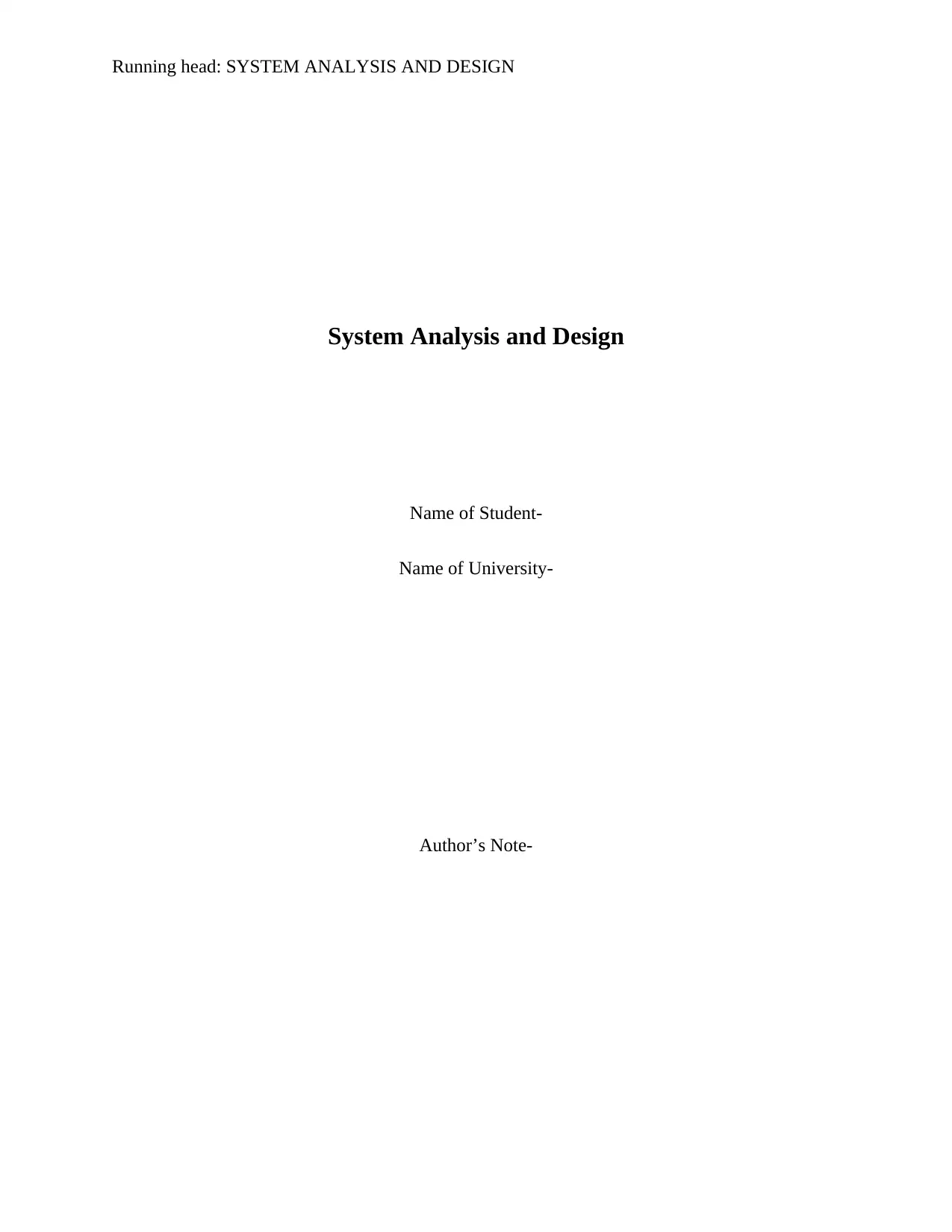
Running head: SYSTEM ANALYSIS AND DESIGN
System Analysis and Design
Name of Student-
Name of University-
Author’s Note-
System Analysis and Design
Name of Student-
Name of University-
Author’s Note-
Secure Best Marks with AI Grader
Need help grading? Try our AI Grader for instant feedback on your assignments.
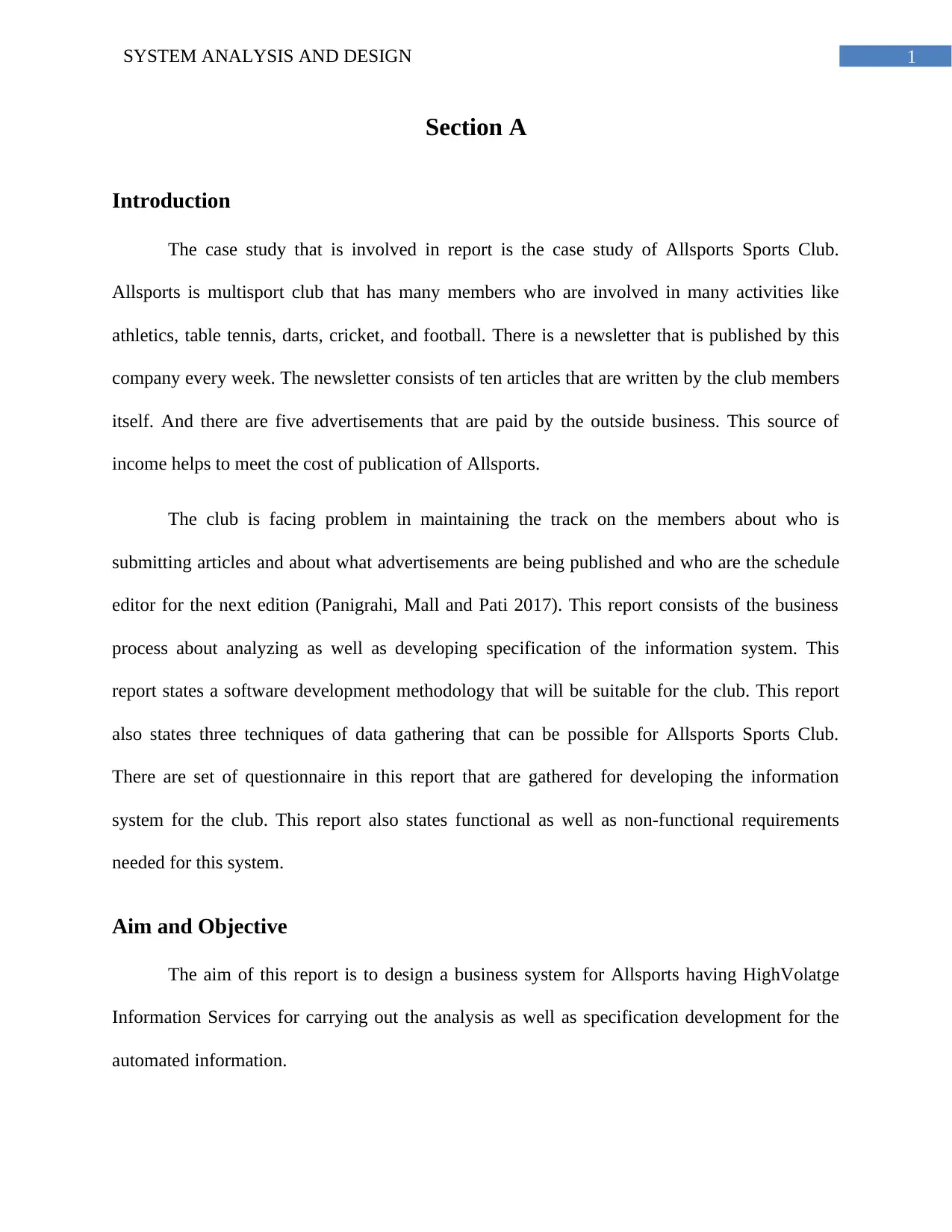
1SYSTEM ANALYSIS AND DESIGN
Section A
Introduction
The case study that is involved in report is the case study of Allsports Sports Club.
Allsports is multisport club that has many members who are involved in many activities like
athletics, table tennis, darts, cricket, and football. There is a newsletter that is published by this
company every week. The newsletter consists of ten articles that are written by the club members
itself. And there are five advertisements that are paid by the outside business. This source of
income helps to meet the cost of publication of Allsports.
The club is facing problem in maintaining the track on the members about who is
submitting articles and about what advertisements are being published and who are the schedule
editor for the next edition (Panigrahi, Mall and Pati 2017). This report consists of the business
process about analyzing as well as developing specification of the information system. This
report states a software development methodology that will be suitable for the club. This report
also states three techniques of data gathering that can be possible for Allsports Sports Club.
There are set of questionnaire in this report that are gathered for developing the information
system for the club. This report also states functional as well as non-functional requirements
needed for this system.
Aim and Objective
The aim of this report is to design a business system for Allsports having HighVolatge
Information Services for carrying out the analysis as well as specification development for the
automated information.
Section A
Introduction
The case study that is involved in report is the case study of Allsports Sports Club.
Allsports is multisport club that has many members who are involved in many activities like
athletics, table tennis, darts, cricket, and football. There is a newsletter that is published by this
company every week. The newsletter consists of ten articles that are written by the club members
itself. And there are five advertisements that are paid by the outside business. This source of
income helps to meet the cost of publication of Allsports.
The club is facing problem in maintaining the track on the members about who is
submitting articles and about what advertisements are being published and who are the schedule
editor for the next edition (Panigrahi, Mall and Pati 2017). This report consists of the business
process about analyzing as well as developing specification of the information system. This
report states a software development methodology that will be suitable for the club. This report
also states three techniques of data gathering that can be possible for Allsports Sports Club.
There are set of questionnaire in this report that are gathered for developing the information
system for the club. This report also states functional as well as non-functional requirements
needed for this system.
Aim and Objective
The aim of this report is to design a business system for Allsports having HighVolatge
Information Services for carrying out the analysis as well as specification development for the
automated information.
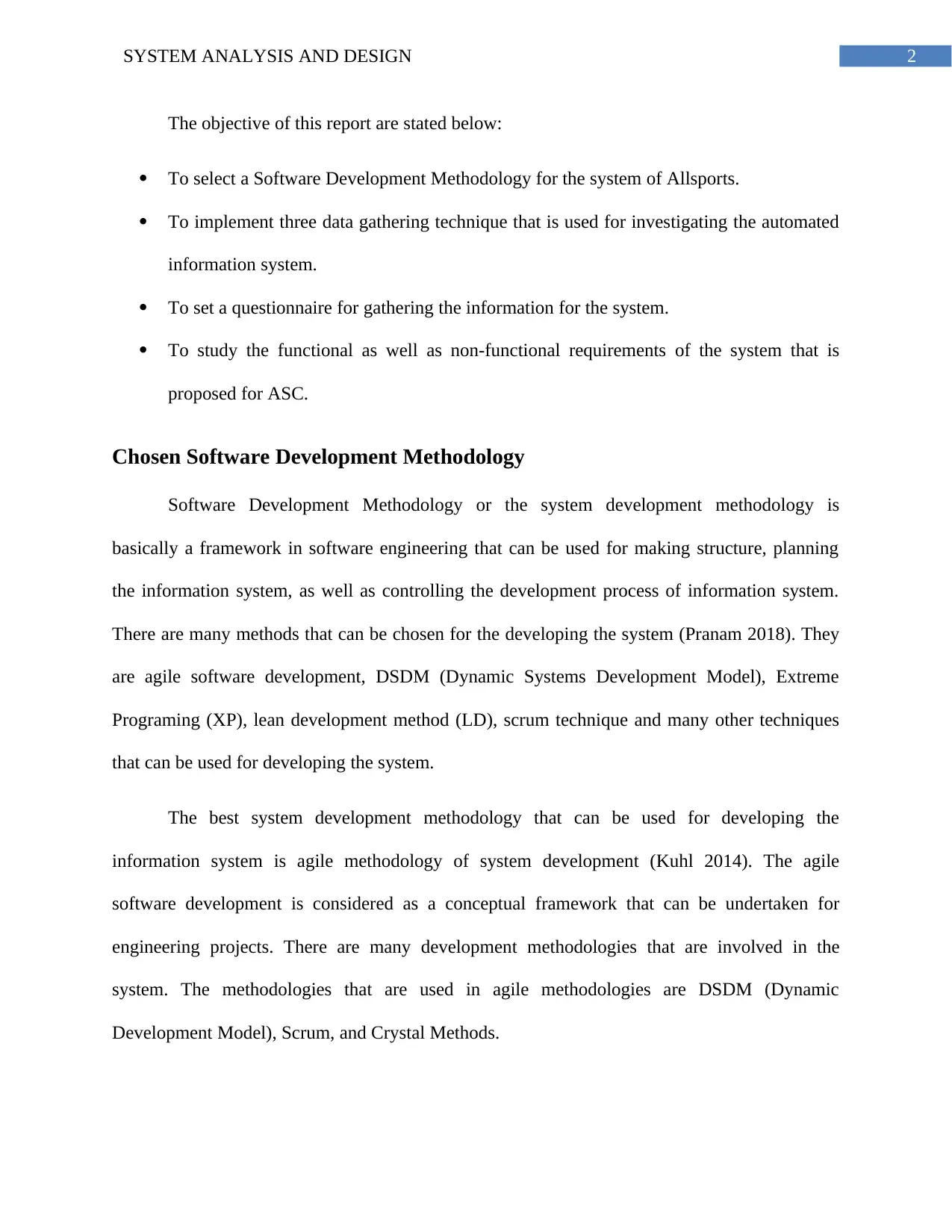
2SYSTEM ANALYSIS AND DESIGN
The objective of this report are stated below:
To select a Software Development Methodology for the system of Allsports.
To implement three data gathering technique that is used for investigating the automated
information system.
To set a questionnaire for gathering the information for the system.
To study the functional as well as non-functional requirements of the system that is
proposed for ASC.
Chosen Software Development Methodology
Software Development Methodology or the system development methodology is
basically a framework in software engineering that can be used for making structure, planning
the information system, as well as controlling the development process of information system.
There are many methods that can be chosen for the developing the system (Pranam 2018). They
are agile software development, DSDM (Dynamic Systems Development Model), Extreme
Programing (XP), lean development method (LD), scrum technique and many other techniques
that can be used for developing the system.
The best system development methodology that can be used for developing the
information system is agile methodology of system development (Kuhl 2014). The agile
software development is considered as a conceptual framework that can be undertaken for
engineering projects. There are many development methodologies that are involved in the
system. The methodologies that are used in agile methodologies are DSDM (Dynamic
Development Model), Scrum, and Crystal Methods.
The objective of this report are stated below:
To select a Software Development Methodology for the system of Allsports.
To implement three data gathering technique that is used for investigating the automated
information system.
To set a questionnaire for gathering the information for the system.
To study the functional as well as non-functional requirements of the system that is
proposed for ASC.
Chosen Software Development Methodology
Software Development Methodology or the system development methodology is
basically a framework in software engineering that can be used for making structure, planning
the information system, as well as controlling the development process of information system.
There are many methods that can be chosen for the developing the system (Pranam 2018). They
are agile software development, DSDM (Dynamic Systems Development Model), Extreme
Programing (XP), lean development method (LD), scrum technique and many other techniques
that can be used for developing the system.
The best system development methodology that can be used for developing the
information system is agile methodology of system development (Kuhl 2014). The agile
software development is considered as a conceptual framework that can be undertaken for
engineering projects. There are many development methodologies that are involved in the
system. The methodologies that are used in agile methodologies are DSDM (Dynamic
Development Model), Scrum, and Crystal Methods.
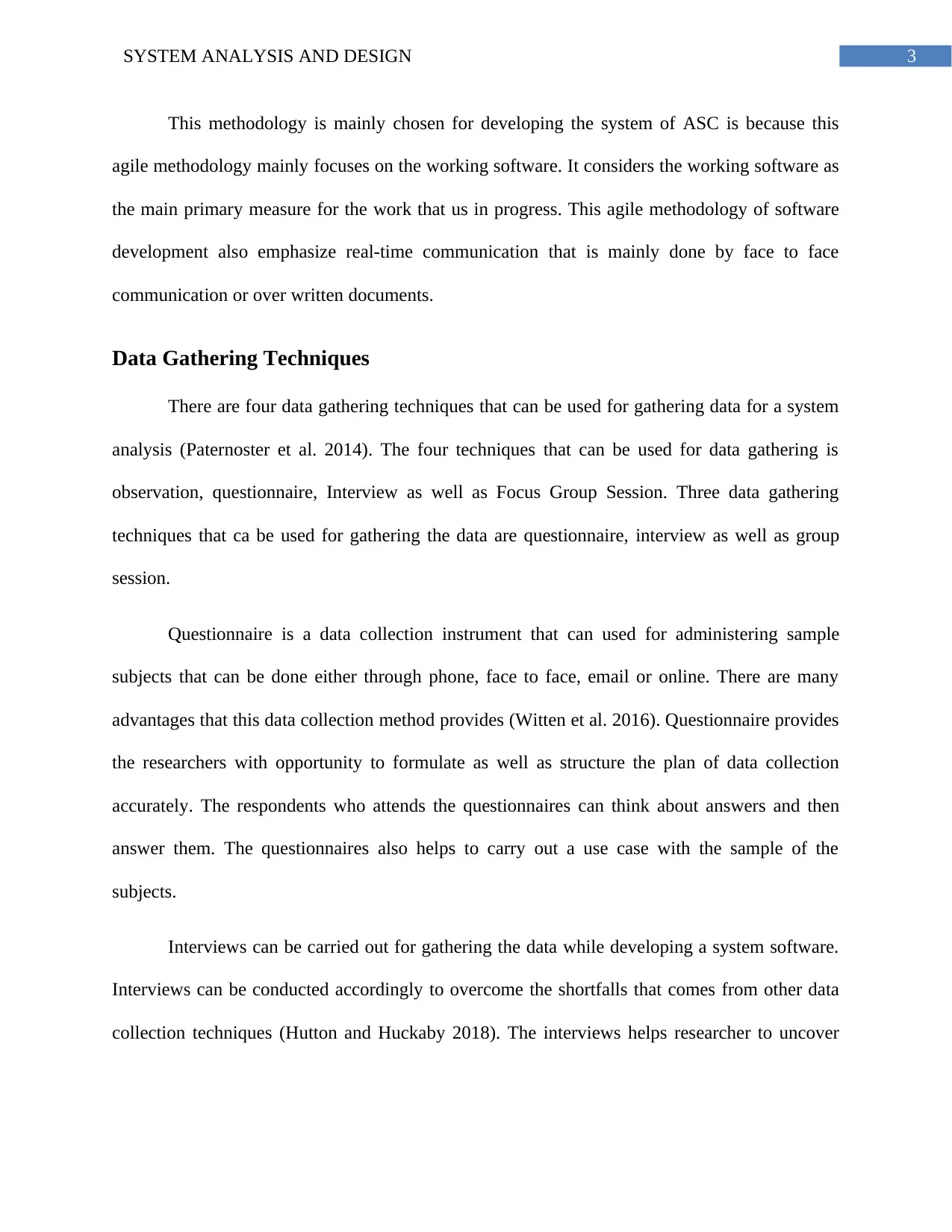
3SYSTEM ANALYSIS AND DESIGN
This methodology is mainly chosen for developing the system of ASC is because this
agile methodology mainly focuses on the working software. It considers the working software as
the main primary measure for the work that us in progress. This agile methodology of software
development also emphasize real-time communication that is mainly done by face to face
communication or over written documents.
Data Gathering Techniques
There are four data gathering techniques that can be used for gathering data for a system
analysis (Paternoster et al. 2014). The four techniques that can be used for data gathering is
observation, questionnaire, Interview as well as Focus Group Session. Three data gathering
techniques that ca be used for gathering the data are questionnaire, interview as well as group
session.
Questionnaire is a data collection instrument that can used for administering sample
subjects that can be done either through phone, face to face, email or online. There are many
advantages that this data collection method provides (Witten et al. 2016). Questionnaire provides
the researchers with opportunity to formulate as well as structure the plan of data collection
accurately. The respondents who attends the questionnaires can think about answers and then
answer them. The questionnaires also helps to carry out a use case with the sample of the
subjects.
Interviews can be carried out for gathering the data while developing a system software.
Interviews can be conducted accordingly to overcome the shortfalls that comes from other data
collection techniques (Hutton and Huckaby 2018). The interviews helps researcher to uncover
This methodology is mainly chosen for developing the system of ASC is because this
agile methodology mainly focuses on the working software. It considers the working software as
the main primary measure for the work that us in progress. This agile methodology of software
development also emphasize real-time communication that is mainly done by face to face
communication or over written documents.
Data Gathering Techniques
There are four data gathering techniques that can be used for gathering data for a system
analysis (Paternoster et al. 2014). The four techniques that can be used for data gathering is
observation, questionnaire, Interview as well as Focus Group Session. Three data gathering
techniques that ca be used for gathering the data are questionnaire, interview as well as group
session.
Questionnaire is a data collection instrument that can used for administering sample
subjects that can be done either through phone, face to face, email or online. There are many
advantages that this data collection method provides (Witten et al. 2016). Questionnaire provides
the researchers with opportunity to formulate as well as structure the plan of data collection
accurately. The respondents who attends the questionnaires can think about answers and then
answer them. The questionnaires also helps to carry out a use case with the sample of the
subjects.
Interviews can be carried out for gathering the data while developing a system software.
Interviews can be conducted accordingly to overcome the shortfalls that comes from other data
collection techniques (Hutton and Huckaby 2018). The interviews helps researcher to uncover
Secure Best Marks with AI Grader
Need help grading? Try our AI Grader for instant feedback on your assignments.
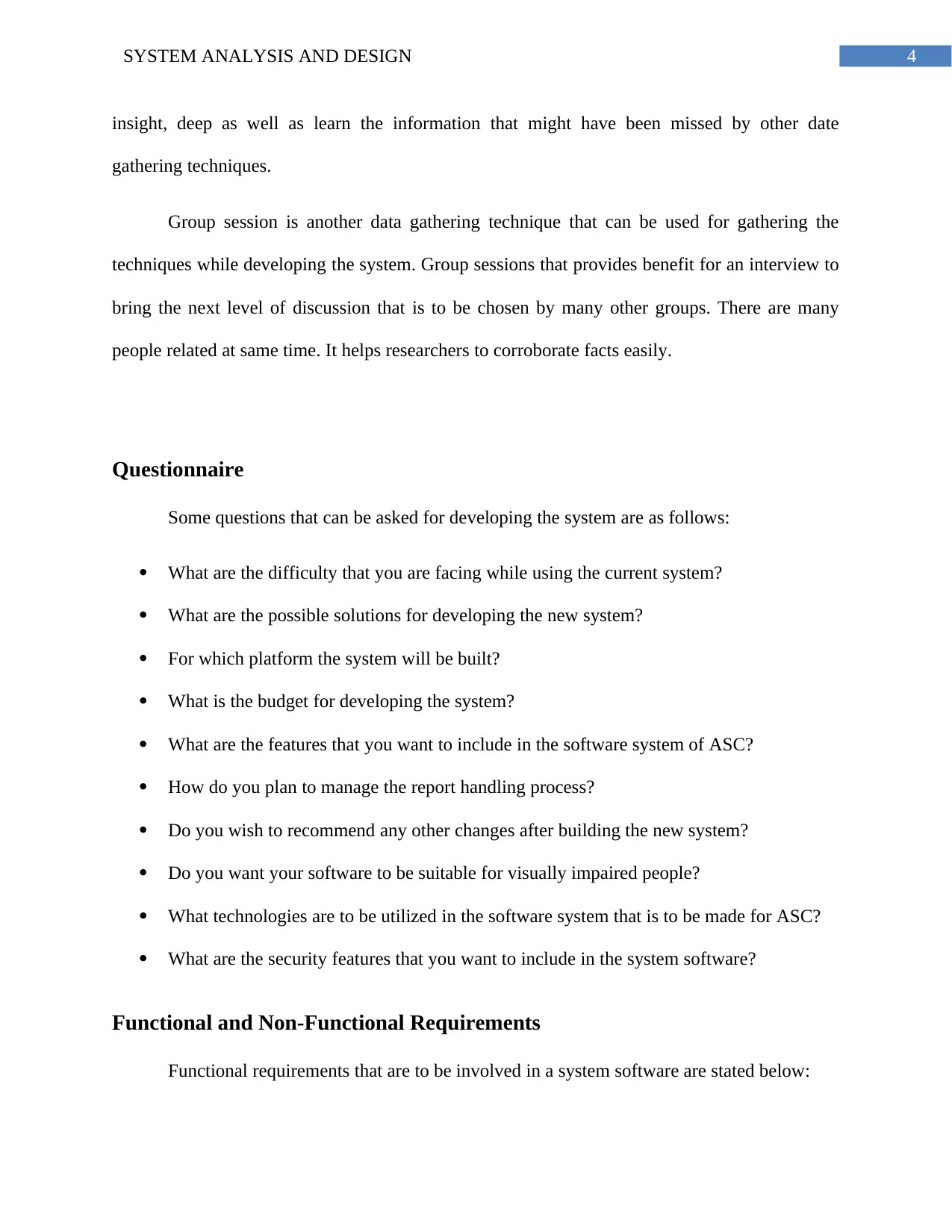
4SYSTEM ANALYSIS AND DESIGN
insight, deep as well as learn the information that might have been missed by other date
gathering techniques.
Group session is another data gathering technique that can be used for gathering the
techniques while developing the system. Group sessions that provides benefit for an interview to
bring the next level of discussion that is to be chosen by many other groups. There are many
people related at same time. It helps researchers to corroborate facts easily.
Questionnaire
Some questions that can be asked for developing the system are as follows:
What are the difficulty that you are facing while using the current system?
What are the possible solutions for developing the new system?
For which platform the system will be built?
What is the budget for developing the system?
What are the features that you want to include in the software system of ASC?
How do you plan to manage the report handling process?
Do you wish to recommend any other changes after building the new system?
Do you want your software to be suitable for visually impaired people?
What technologies are to be utilized in the software system that is to be made for ASC?
What are the security features that you want to include in the system software?
Functional and Non-Functional Requirements
Functional requirements that are to be involved in a system software are stated below:
insight, deep as well as learn the information that might have been missed by other date
gathering techniques.
Group session is another data gathering technique that can be used for gathering the
techniques while developing the system. Group sessions that provides benefit for an interview to
bring the next level of discussion that is to be chosen by many other groups. There are many
people related at same time. It helps researchers to corroborate facts easily.
Questionnaire
Some questions that can be asked for developing the system are as follows:
What are the difficulty that you are facing while using the current system?
What are the possible solutions for developing the new system?
For which platform the system will be built?
What is the budget for developing the system?
What are the features that you want to include in the software system of ASC?
How do you plan to manage the report handling process?
Do you wish to recommend any other changes after building the new system?
Do you want your software to be suitable for visually impaired people?
What technologies are to be utilized in the software system that is to be made for ASC?
What are the security features that you want to include in the system software?
Functional and Non-Functional Requirements
Functional requirements that are to be involved in a system software are stated below:
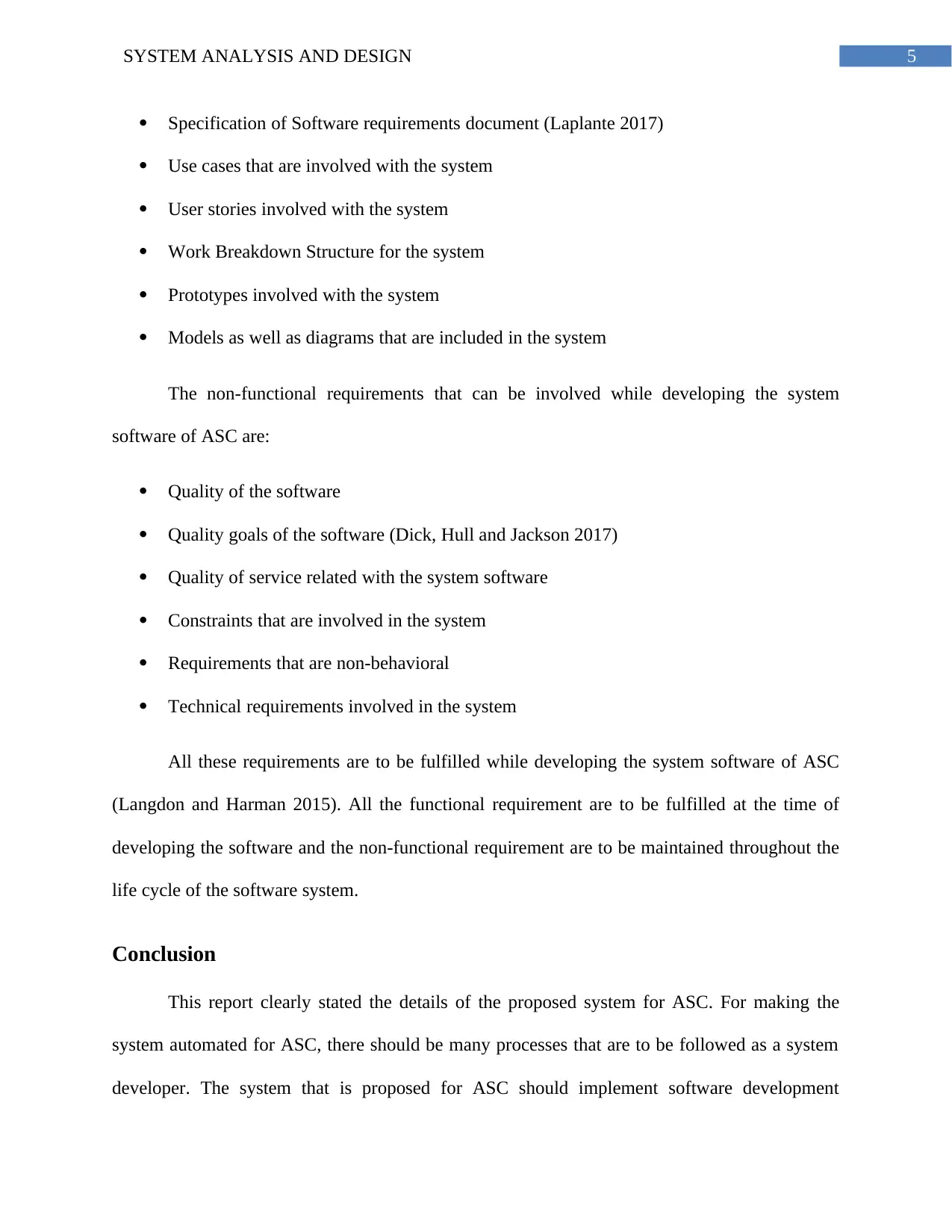
5SYSTEM ANALYSIS AND DESIGN
Specification of Software requirements document (Laplante 2017)
Use cases that are involved with the system
User stories involved with the system
Work Breakdown Structure for the system
Prototypes involved with the system
Models as well as diagrams that are included in the system
The non-functional requirements that can be involved while developing the system
software of ASC are:
Quality of the software
Quality goals of the software (Dick, Hull and Jackson 2017)
Quality of service related with the system software
Constraints that are involved in the system
Requirements that are non-behavioral
Technical requirements involved in the system
All these requirements are to be fulfilled while developing the system software of ASC
(Langdon and Harman 2015). All the functional requirement are to be fulfilled at the time of
developing the software and the non-functional requirement are to be maintained throughout the
life cycle of the software system.
Conclusion
This report clearly stated the details of the proposed system for ASC. For making the
system automated for ASC, there should be many processes that are to be followed as a system
developer. The system that is proposed for ASC should implement software development
Specification of Software requirements document (Laplante 2017)
Use cases that are involved with the system
User stories involved with the system
Work Breakdown Structure for the system
Prototypes involved with the system
Models as well as diagrams that are included in the system
The non-functional requirements that can be involved while developing the system
software of ASC are:
Quality of the software
Quality goals of the software (Dick, Hull and Jackson 2017)
Quality of service related with the system software
Constraints that are involved in the system
Requirements that are non-behavioral
Technical requirements involved in the system
All these requirements are to be fulfilled while developing the system software of ASC
(Langdon and Harman 2015). All the functional requirement are to be fulfilled at the time of
developing the software and the non-functional requirement are to be maintained throughout the
life cycle of the software system.
Conclusion
This report clearly stated the details of the proposed system for ASC. For making the
system automated for ASC, there should be many processes that are to be followed as a system
developer. The system that is proposed for ASC should implement software development
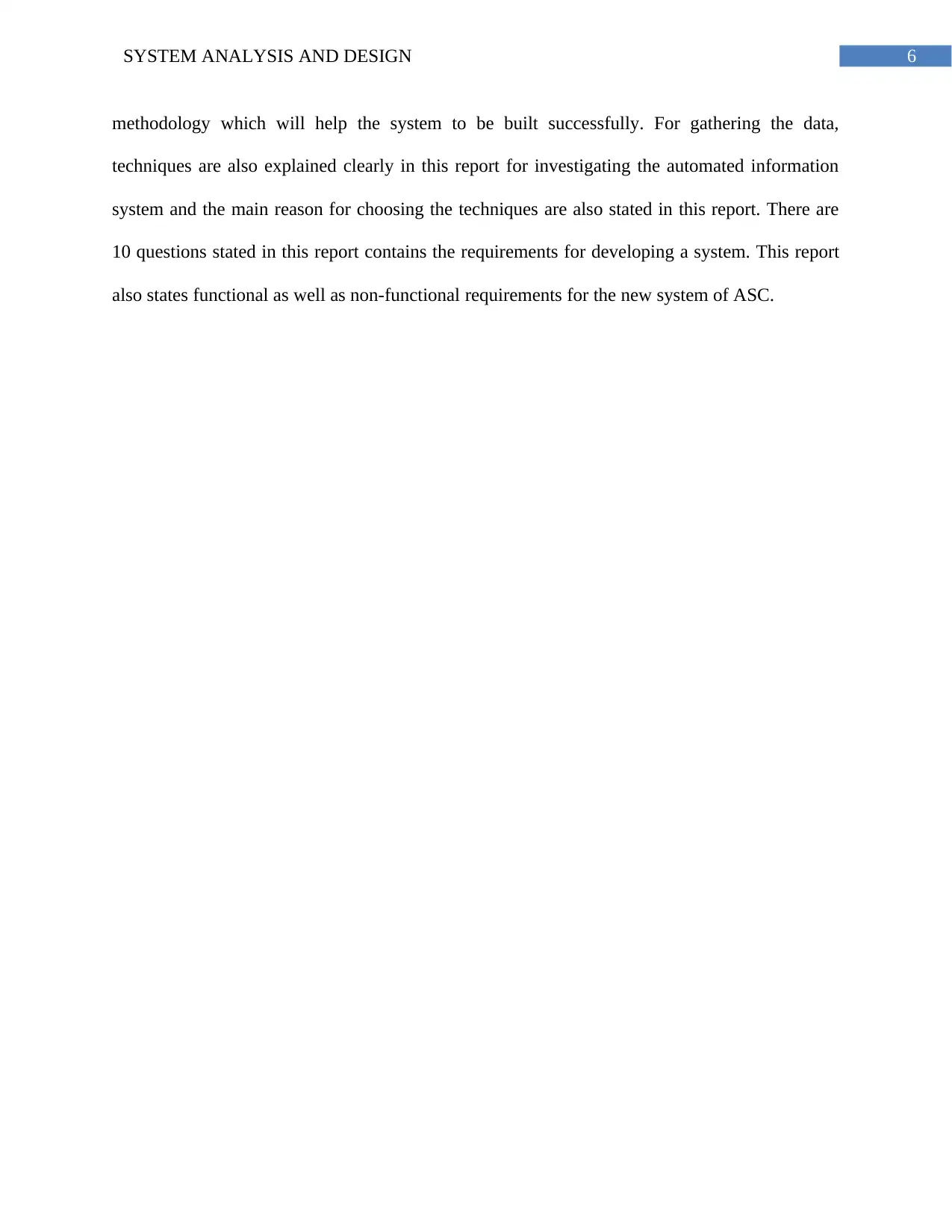
6SYSTEM ANALYSIS AND DESIGN
methodology which will help the system to be built successfully. For gathering the data,
techniques are also explained clearly in this report for investigating the automated information
system and the main reason for choosing the techniques are also stated in this report. There are
10 questions stated in this report contains the requirements for developing a system. This report
also states functional as well as non-functional requirements for the new system of ASC.
methodology which will help the system to be built successfully. For gathering the data,
techniques are also explained clearly in this report for investigating the automated information
system and the main reason for choosing the techniques are also stated in this report. There are
10 questions stated in this report contains the requirements for developing a system. This report
also states functional as well as non-functional requirements for the new system of ASC.
Paraphrase This Document
Need a fresh take? Get an instant paraphrase of this document with our AI Paraphraser
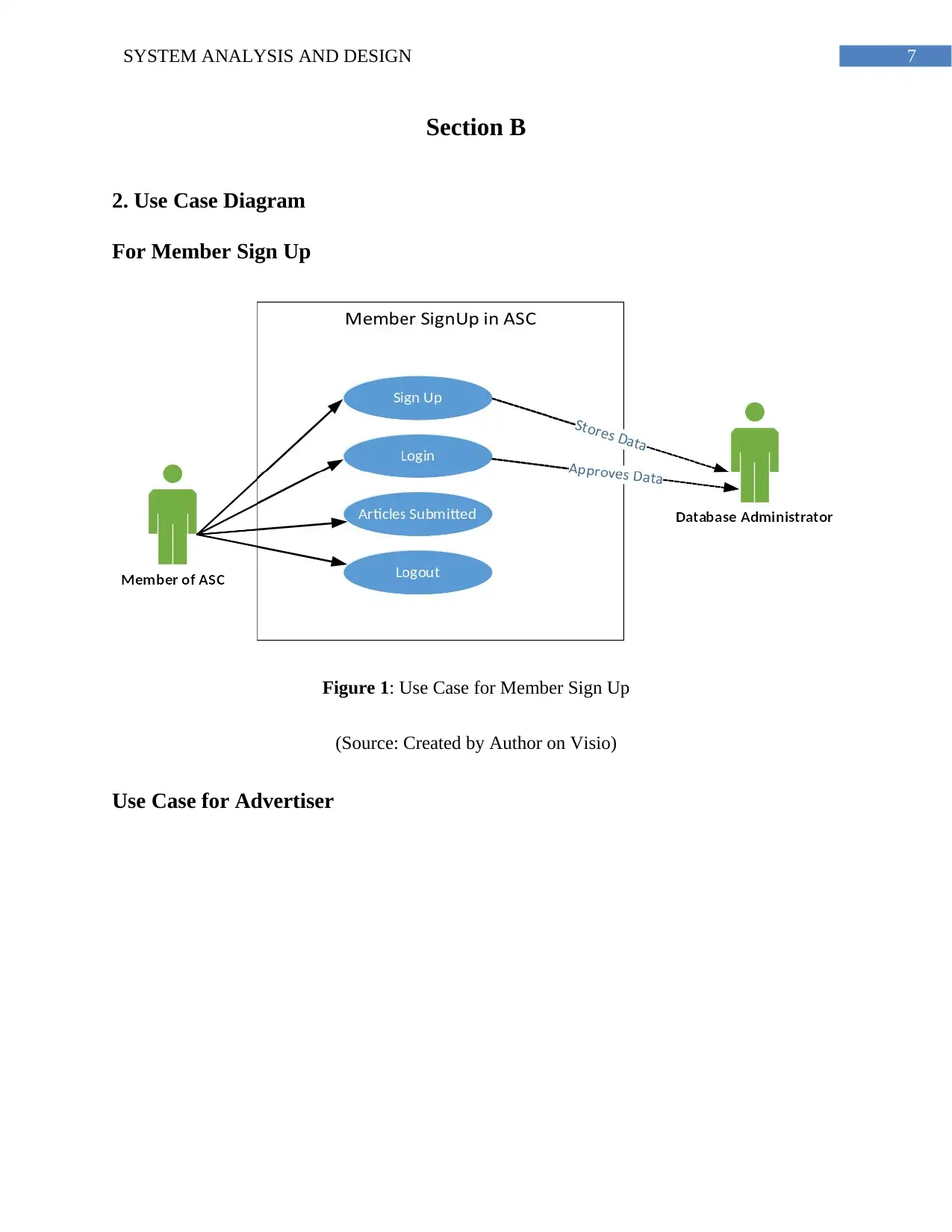
7SYSTEM ANALYSIS AND DESIGN
Section B
2. Use Case Diagram
For Member Sign Up
Figure 1: Use Case for Member Sign Up
(Source: Created by Author on Visio)
Use Case for Advertiser
Section B
2. Use Case Diagram
For Member Sign Up
Figure 1: Use Case for Member Sign Up
(Source: Created by Author on Visio)
Use Case for Advertiser
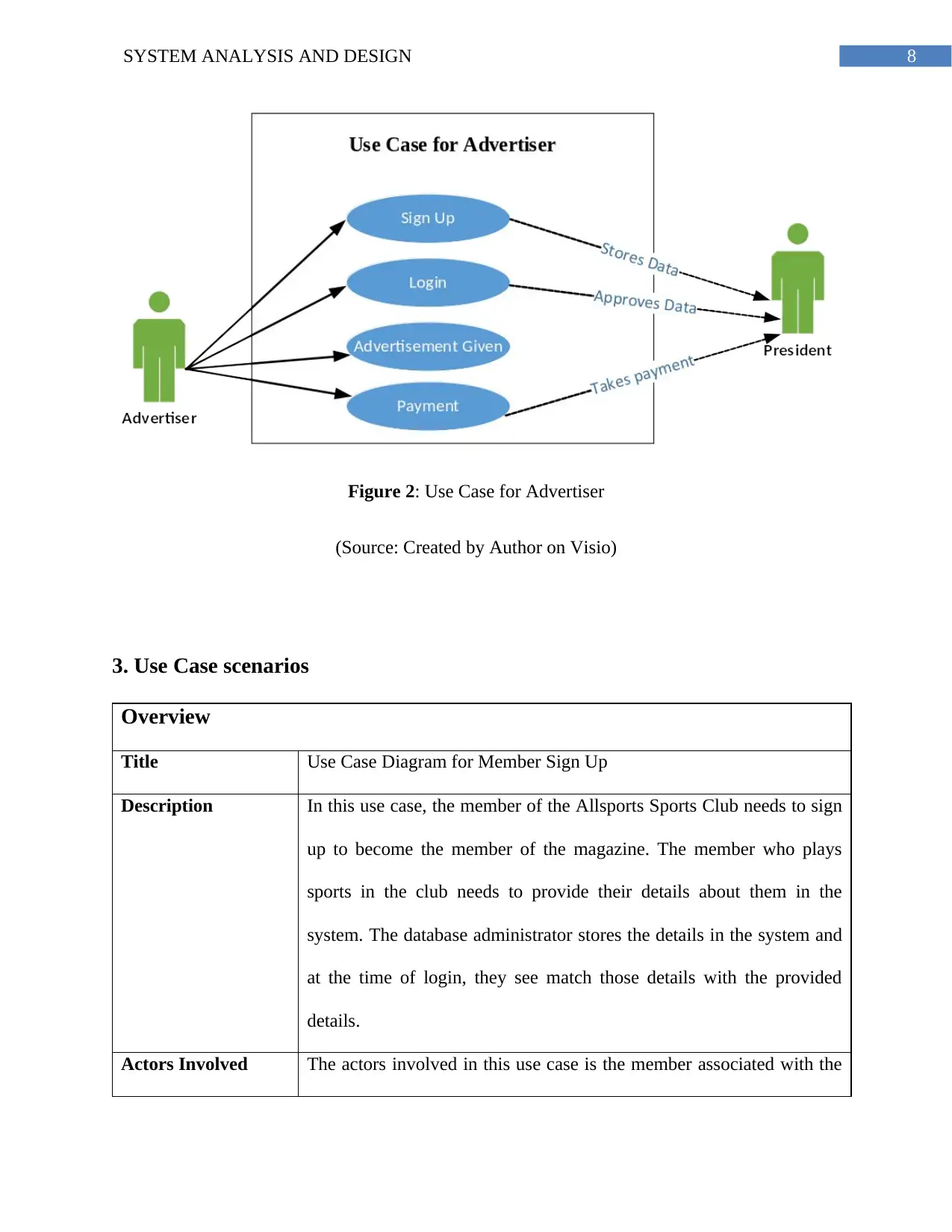
8SYSTEM ANALYSIS AND DESIGN
Figure 2: Use Case for Advertiser
(Source: Created by Author on Visio)
3. Use Case scenarios
Overview
Title Use Case Diagram for Member Sign Up
Description In this use case, the member of the Allsports Sports Club needs to sign
up to become the member of the magazine. The member who plays
sports in the club needs to provide their details about them in the
system. The database administrator stores the details in the system and
at the time of login, they see match those details with the provided
details.
Actors Involved The actors involved in this use case is the member associated with the
Figure 2: Use Case for Advertiser
(Source: Created by Author on Visio)
3. Use Case scenarios
Overview
Title Use Case Diagram for Member Sign Up
Description In this use case, the member of the Allsports Sports Club needs to sign
up to become the member of the magazine. The member who plays
sports in the club needs to provide their details about them in the
system. The database administrator stores the details in the system and
at the time of login, they see match those details with the provided
details.
Actors Involved The actors involved in this use case is the member associated with the
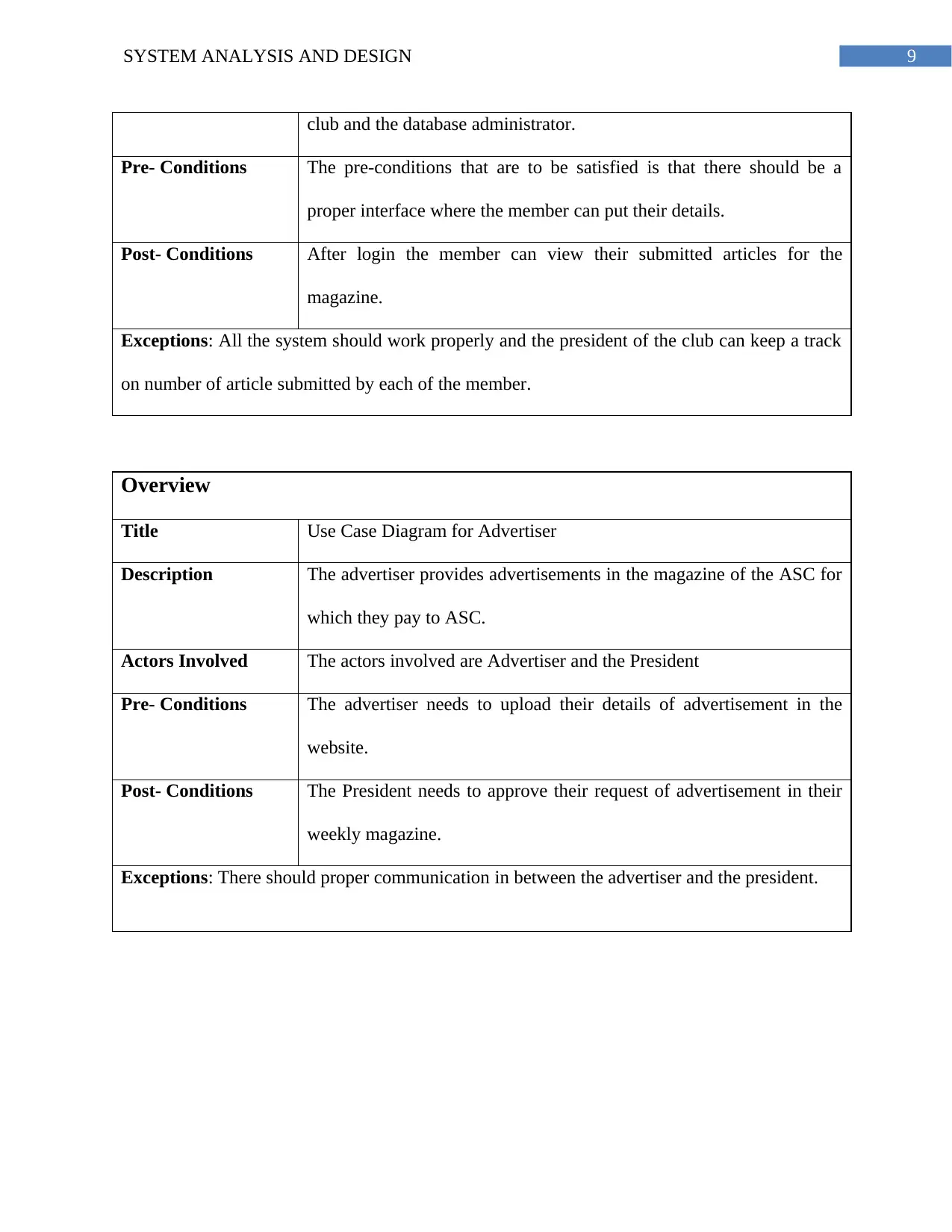
9SYSTEM ANALYSIS AND DESIGN
club and the database administrator.
Pre- Conditions The pre-conditions that are to be satisfied is that there should be a
proper interface where the member can put their details.
Post- Conditions After login the member can view their submitted articles for the
magazine.
Exceptions: All the system should work properly and the president of the club can keep a track
on number of article submitted by each of the member.
Overview
Title Use Case Diagram for Advertiser
Description The advertiser provides advertisements in the magazine of the ASC for
which they pay to ASC.
Actors Involved The actors involved are Advertiser and the President
Pre- Conditions The advertiser needs to upload their details of advertisement in the
website.
Post- Conditions The President needs to approve their request of advertisement in their
weekly magazine.
Exceptions: There should proper communication in between the advertiser and the president.
club and the database administrator.
Pre- Conditions The pre-conditions that are to be satisfied is that there should be a
proper interface where the member can put their details.
Post- Conditions After login the member can view their submitted articles for the
magazine.
Exceptions: All the system should work properly and the president of the club can keep a track
on number of article submitted by each of the member.
Overview
Title Use Case Diagram for Advertiser
Description The advertiser provides advertisements in the magazine of the ASC for
which they pay to ASC.
Actors Involved The actors involved are Advertiser and the President
Pre- Conditions The advertiser needs to upload their details of advertisement in the
website.
Post- Conditions The President needs to approve their request of advertisement in their
weekly magazine.
Exceptions: There should proper communication in between the advertiser and the president.
Secure Best Marks with AI Grader
Need help grading? Try our AI Grader for instant feedback on your assignments.
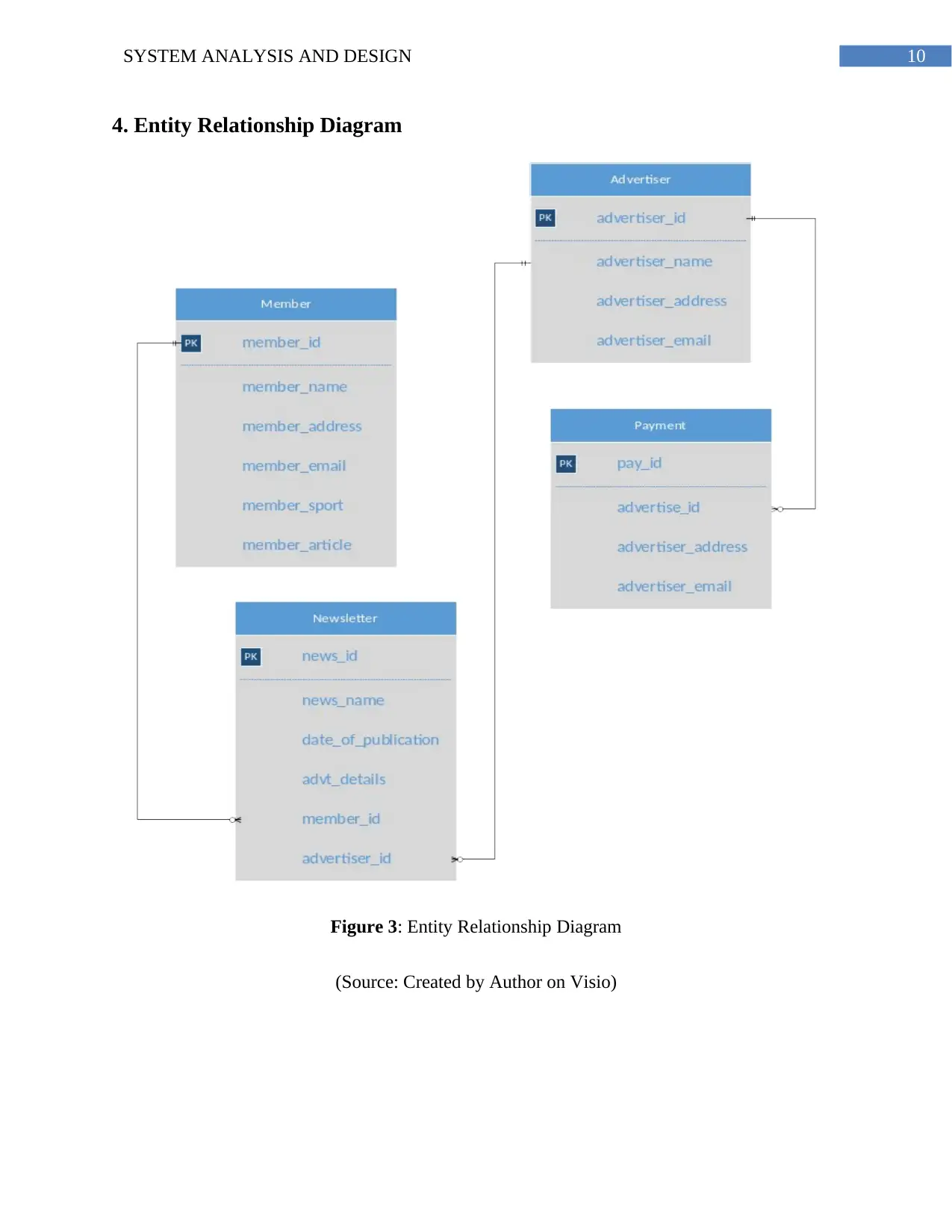
10SYSTEM ANALYSIS AND DESIGN
4. Entity Relationship Diagram
Figure 3: Entity Relationship Diagram
(Source: Created by Author on Visio)
4. Entity Relationship Diagram
Figure 3: Entity Relationship Diagram
(Source: Created by Author on Visio)
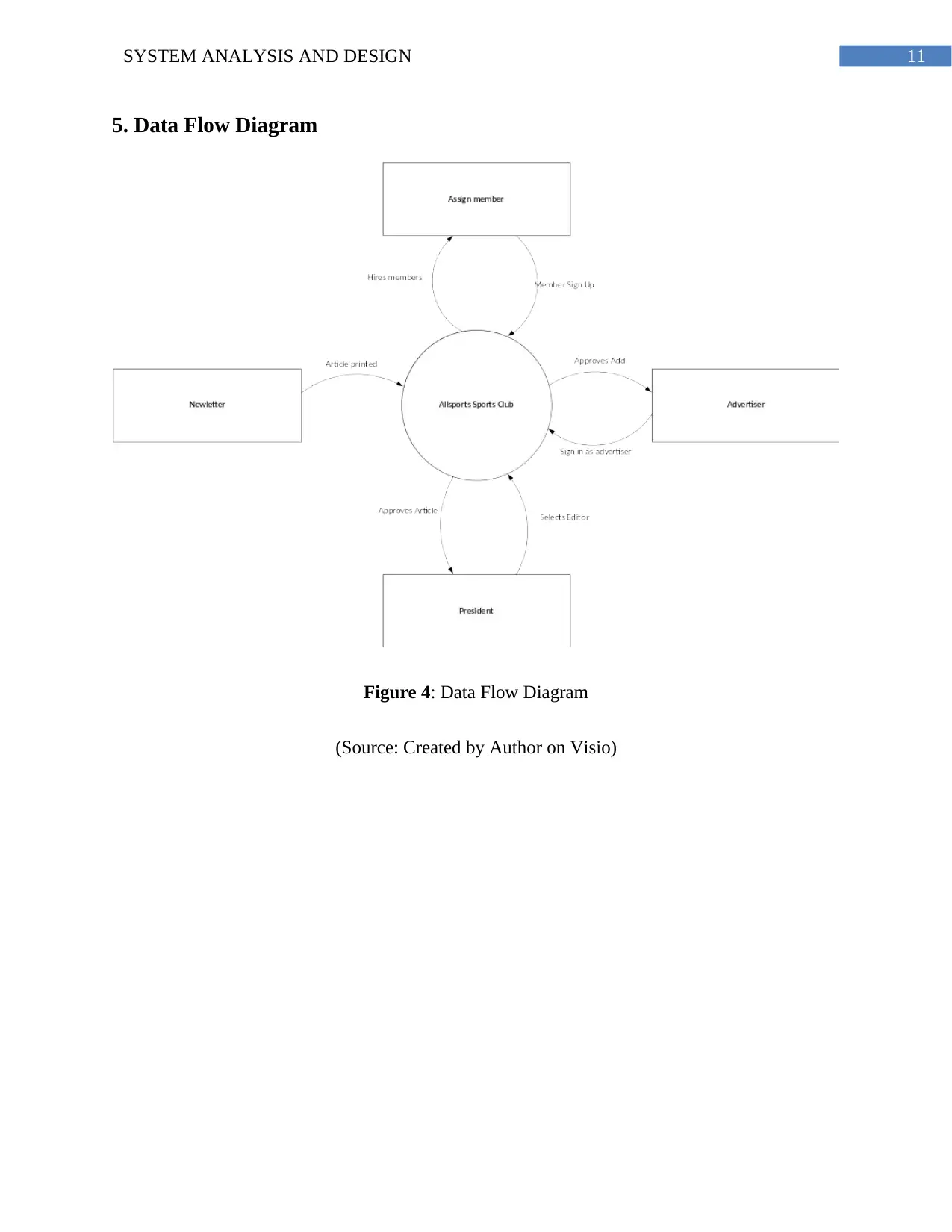
11SYSTEM ANALYSIS AND DESIGN
5. Data Flow Diagram
Figure 4: Data Flow Diagram
(Source: Created by Author on Visio)
5. Data Flow Diagram
Figure 4: Data Flow Diagram
(Source: Created by Author on Visio)
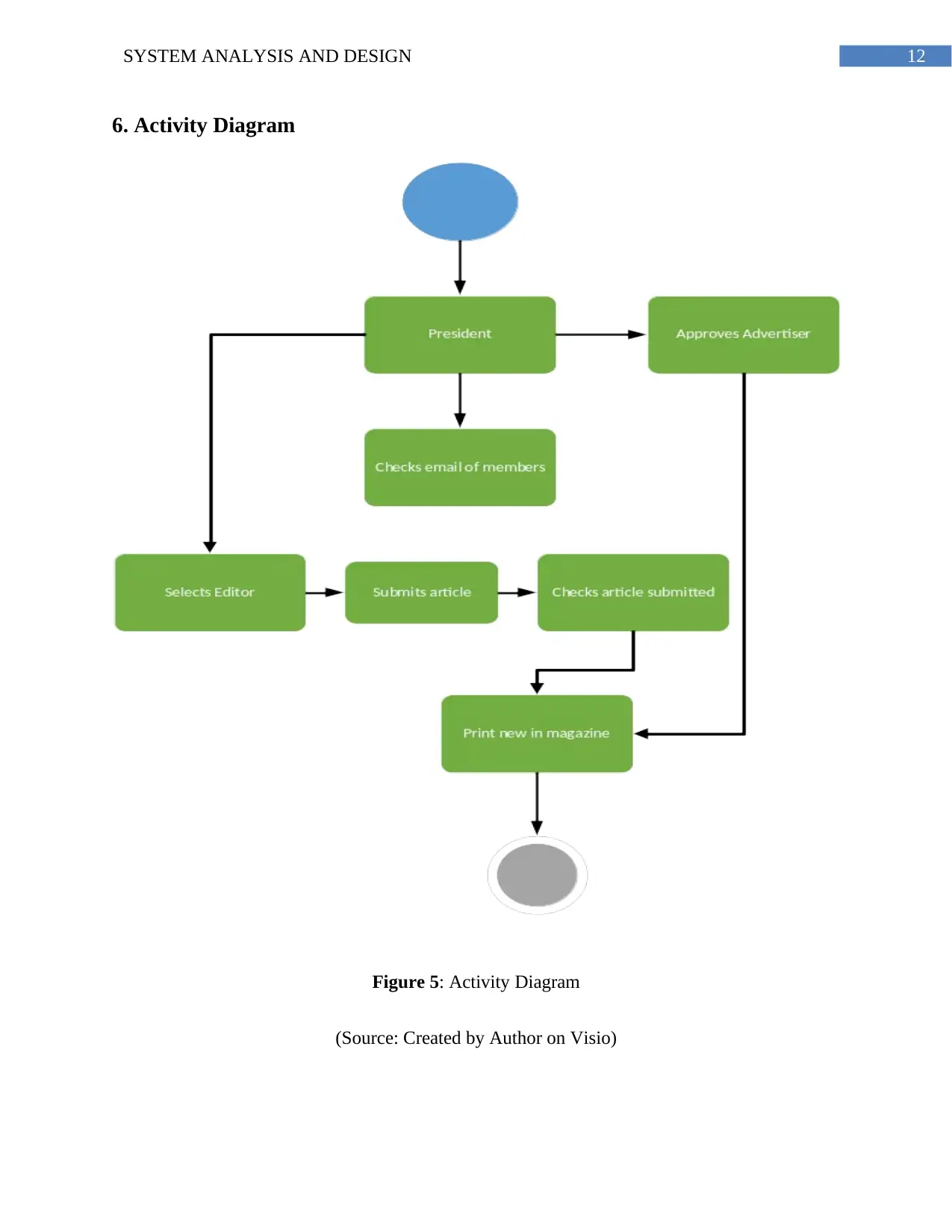
12SYSTEM ANALYSIS AND DESIGN
6. Activity Diagram
Figure 5: Activity Diagram
(Source: Created by Author on Visio)
6. Activity Diagram
Figure 5: Activity Diagram
(Source: Created by Author on Visio)
Paraphrase This Document
Need a fresh take? Get an instant paraphrase of this document with our AI Paraphraser
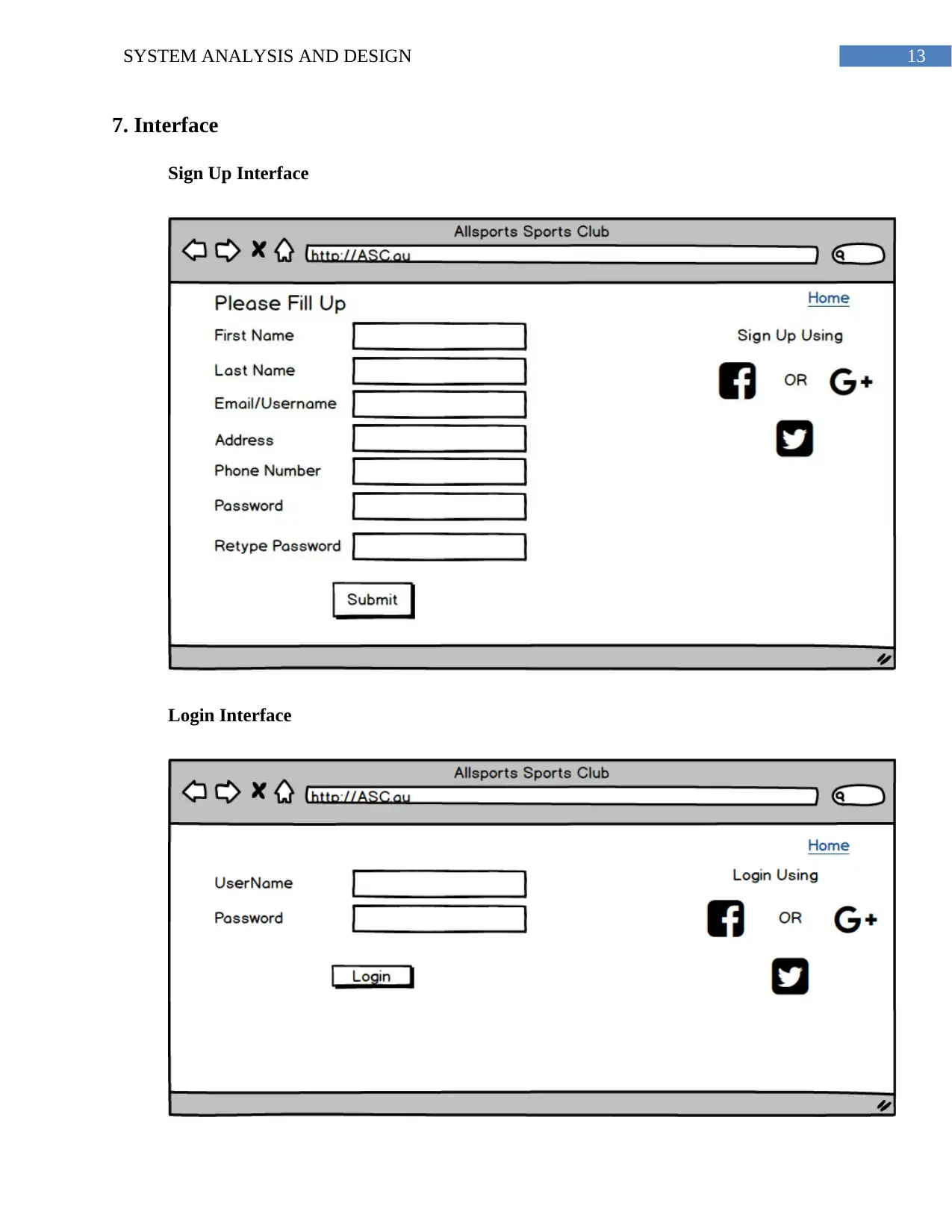
13SYSTEM ANALYSIS AND DESIGN
7. Interface
Sign Up Interface
Login Interface
7. Interface
Sign Up Interface
Login Interface
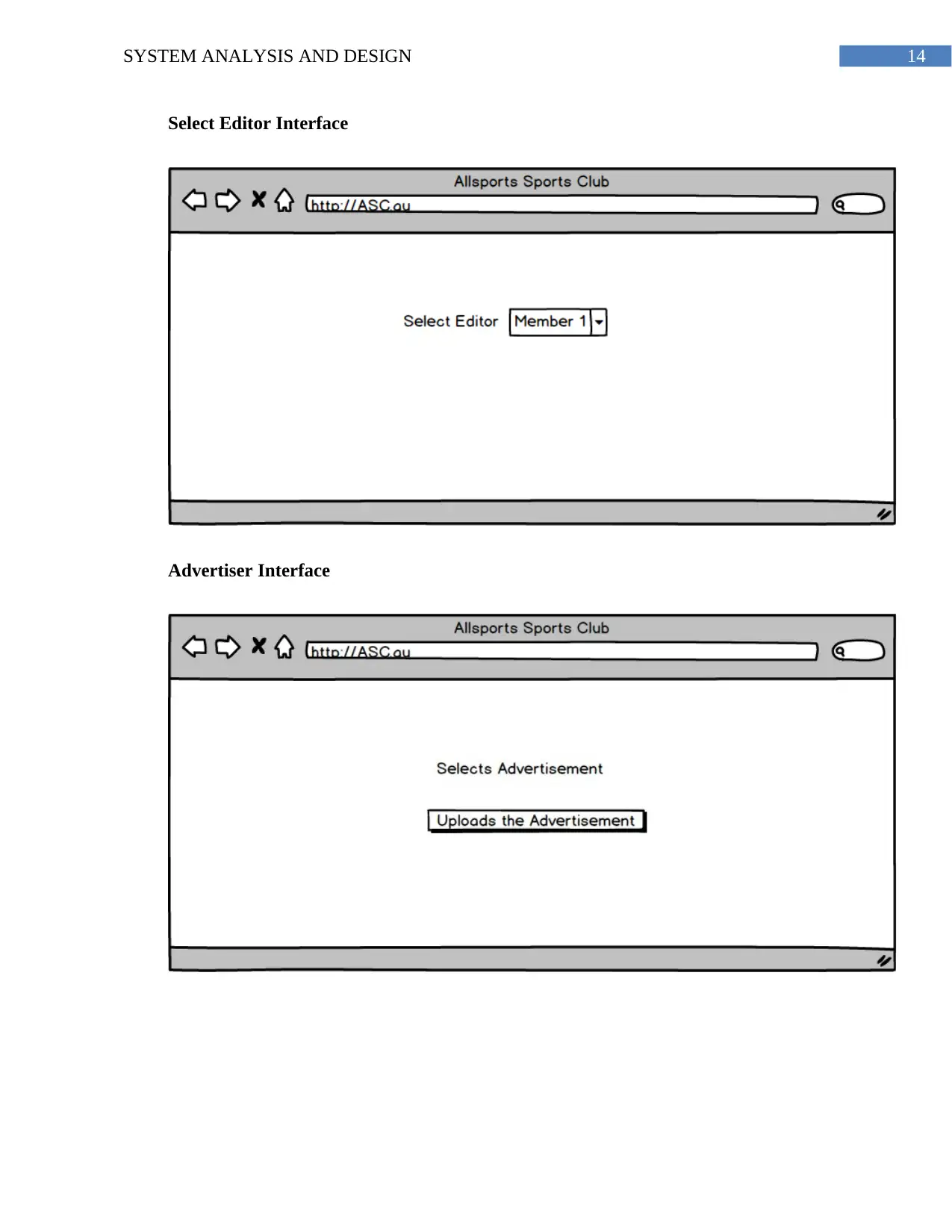
14SYSTEM ANALYSIS AND DESIGN
Select Editor Interface
Advertiser Interface
Select Editor Interface
Advertiser Interface
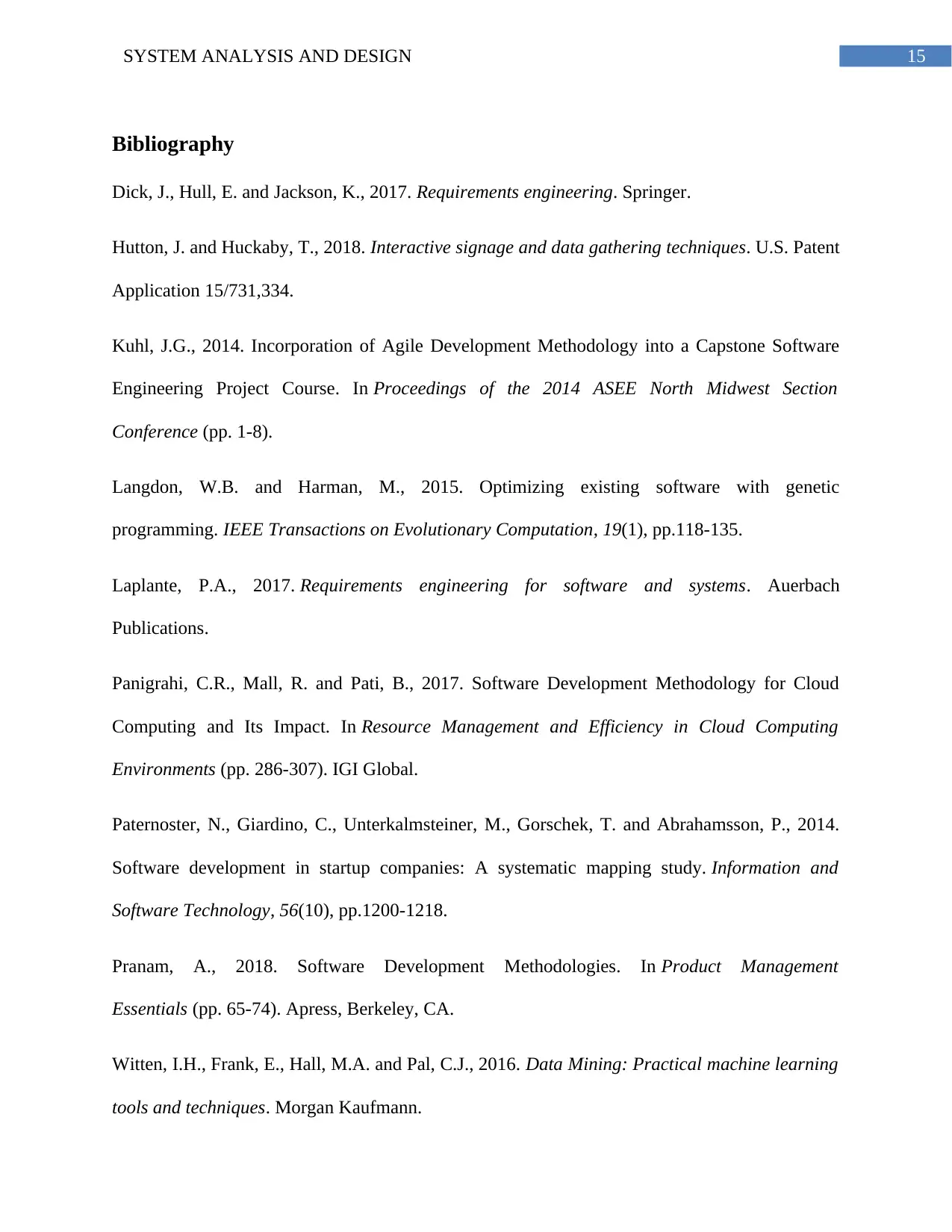
15SYSTEM ANALYSIS AND DESIGN
Bibliography
Dick, J., Hull, E. and Jackson, K., 2017. Requirements engineering. Springer.
Hutton, J. and Huckaby, T., 2018. Interactive signage and data gathering techniques. U.S. Patent
Application 15/731,334.
Kuhl, J.G., 2014. Incorporation of Agile Development Methodology into a Capstone Software
Engineering Project Course. In Proceedings of the 2014 ASEE North Midwest Section
Conference (pp. 1-8).
Langdon, W.B. and Harman, M., 2015. Optimizing existing software with genetic
programming. IEEE Transactions on Evolutionary Computation, 19(1), pp.118-135.
Laplante, P.A., 2017. Requirements engineering for software and systems. Auerbach
Publications.
Panigrahi, C.R., Mall, R. and Pati, B., 2017. Software Development Methodology for Cloud
Computing and Its Impact. In Resource Management and Efficiency in Cloud Computing
Environments (pp. 286-307). IGI Global.
Paternoster, N., Giardino, C., Unterkalmsteiner, M., Gorschek, T. and Abrahamsson, P., 2014.
Software development in startup companies: A systematic mapping study. Information and
Software Technology, 56(10), pp.1200-1218.
Pranam, A., 2018. Software Development Methodologies. In Product Management
Essentials (pp. 65-74). Apress, Berkeley, CA.
Witten, I.H., Frank, E., Hall, M.A. and Pal, C.J., 2016. Data Mining: Practical machine learning
tools and techniques. Morgan Kaufmann.
Bibliography
Dick, J., Hull, E. and Jackson, K., 2017. Requirements engineering. Springer.
Hutton, J. and Huckaby, T., 2018. Interactive signage and data gathering techniques. U.S. Patent
Application 15/731,334.
Kuhl, J.G., 2014. Incorporation of Agile Development Methodology into a Capstone Software
Engineering Project Course. In Proceedings of the 2014 ASEE North Midwest Section
Conference (pp. 1-8).
Langdon, W.B. and Harman, M., 2015. Optimizing existing software with genetic
programming. IEEE Transactions on Evolutionary Computation, 19(1), pp.118-135.
Laplante, P.A., 2017. Requirements engineering for software and systems. Auerbach
Publications.
Panigrahi, C.R., Mall, R. and Pati, B., 2017. Software Development Methodology for Cloud
Computing and Its Impact. In Resource Management and Efficiency in Cloud Computing
Environments (pp. 286-307). IGI Global.
Paternoster, N., Giardino, C., Unterkalmsteiner, M., Gorschek, T. and Abrahamsson, P., 2014.
Software development in startup companies: A systematic mapping study. Information and
Software Technology, 56(10), pp.1200-1218.
Pranam, A., 2018. Software Development Methodologies. In Product Management
Essentials (pp. 65-74). Apress, Berkeley, CA.
Witten, I.H., Frank, E., Hall, M.A. and Pal, C.J., 2016. Data Mining: Practical machine learning
tools and techniques. Morgan Kaufmann.
Secure Best Marks with AI Grader
Need help grading? Try our AI Grader for instant feedback on your assignments.

16SYSTEM ANALYSIS AND DESIGN
1 out of 17
Related Documents
Your All-in-One AI-Powered Toolkit for Academic Success.
+13062052269
info@desklib.com
Available 24*7 on WhatsApp / Email
![[object Object]](/_next/static/media/star-bottom.7253800d.svg)
Unlock your academic potential
© 2024 | Zucol Services PVT LTD | All rights reserved.





